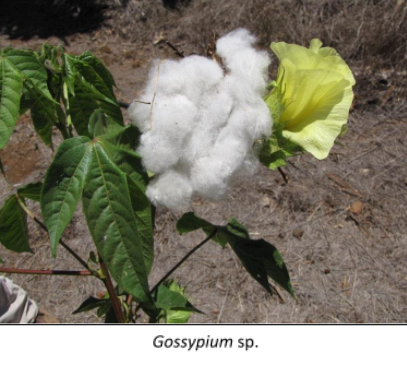Answer
396.6k+ views
Hint: Gossypium is a plant from which we get cultivated cotton. Most of these have diploid genetic constitution while five species have tetraploid constitution.
Complete answer: Gossypium is a genus belonging to the mallow family of Malvaceae. These are flowering plants from which cotton is harvested. In the tropical and subtropical regions of both old and new worlds, these species are found. Gossypium plants have about 50 species. Hence, it is the largest genus in the Gossypieae tribe.
Still, more species are being discovered.
The wild cotton species of this genus have a diploid constitution (2n). In the new world species, which are found in America and the Pacific islands (G. hirsutum, G. barbedens) are tetraploid (4n).

Additional information: Gossypium arboreum var. neglecta, locally known as "Phuti karpas", is the variety used to make Muslin in Bangladesh.
The variation could only be grown in regions south of Dacca, along the banks of the Meghna River. It could be spun so that individual threads could maintain tensile strength at counts higher than any other variety of cotton
G. herbaceum has high stems that grow 2 feet to 6 feet high with wide, hairy leaves. Their flowers are very small and yellow in color with a purple center.
The plant exhibits extrafloral nectaries .
So, the correct option is D. Old world 2n and new world 4n.
Note: The difference in the genetic constitution is due to a single hybridization event nearly 1.5-2 million years ago. This genetic diversity can be exploited to broaden the genetic base of cotton.
Complete answer: Gossypium is a genus belonging to the mallow family of Malvaceae. These are flowering plants from which cotton is harvested. In the tropical and subtropical regions of both old and new worlds, these species are found. Gossypium plants have about 50 species. Hence, it is the largest genus in the Gossypieae tribe.
Still, more species are being discovered.
The wild cotton species of this genus have a diploid constitution (2n). In the new world species, which are found in America and the Pacific islands (G. hirsutum, G. barbedens) are tetraploid (4n).

Additional information: Gossypium arboreum var. neglecta, locally known as "Phuti karpas", is the variety used to make Muslin in Bangladesh.
The variation could only be grown in regions south of Dacca, along the banks of the Meghna River. It could be spun so that individual threads could maintain tensile strength at counts higher than any other variety of cotton
G. herbaceum has high stems that grow 2 feet to 6 feet high with wide, hairy leaves. Their flowers are very small and yellow in color with a purple center.
The plant exhibits extrafloral nectaries .
So, the correct option is D. Old world 2n and new world 4n.
Note: The difference in the genetic constitution is due to a single hybridization event nearly 1.5-2 million years ago. This genetic diversity can be exploited to broaden the genetic base of cotton.
Recently Updated Pages
How do you arrange NH4 + BF3 H2O C2H2 in increasing class 11 chemistry CBSE

Is H mCT and q mCT the same thing If so which is more class 11 chemistry CBSE

What are the possible quantum number for the last outermost class 11 chemistry CBSE

Is C2 paramagnetic or diamagnetic class 11 chemistry CBSE

What happens when entropy reaches maximum class 11 chemistry JEE_Main

Calculate the volume occupied by 88 gram of CO2 at class 11 chemistry CBSE

Trending doubts
Difference between Prokaryotic cell and Eukaryotic class 11 biology CBSE

Difference Between Plant Cell and Animal Cell

Fill the blanks with the suitable prepositions 1 The class 9 english CBSE

Change the following sentences into negative and interrogative class 10 english CBSE

Give 10 examples for herbs , shrubs , climbers , creepers

What organs are located on the left side of your body class 11 biology CBSE

Write an application to the principal requesting five class 10 english CBSE

What is the type of food and mode of feeding of the class 11 biology CBSE

Name 10 Living and Non living things class 9 biology CBSE



